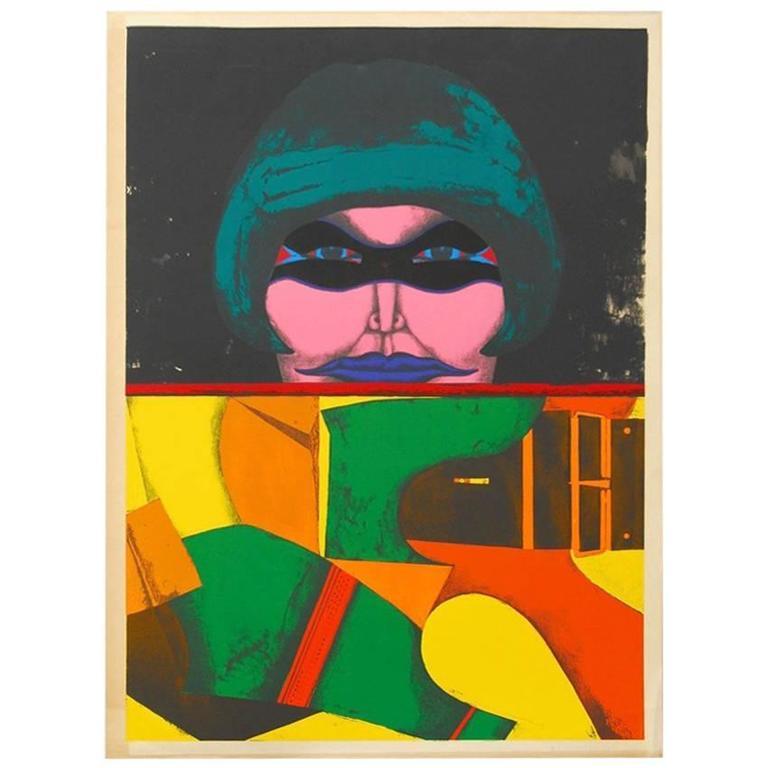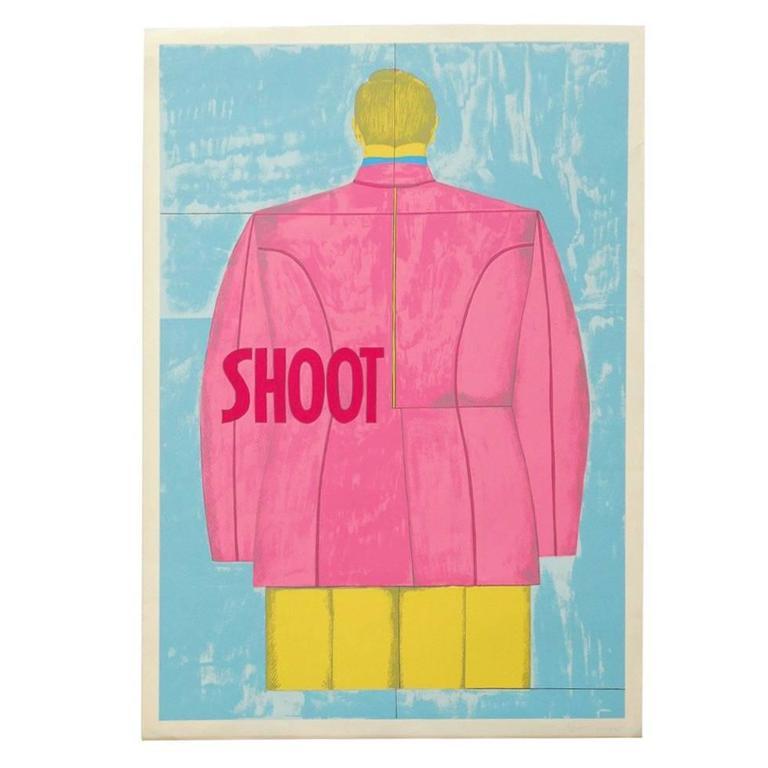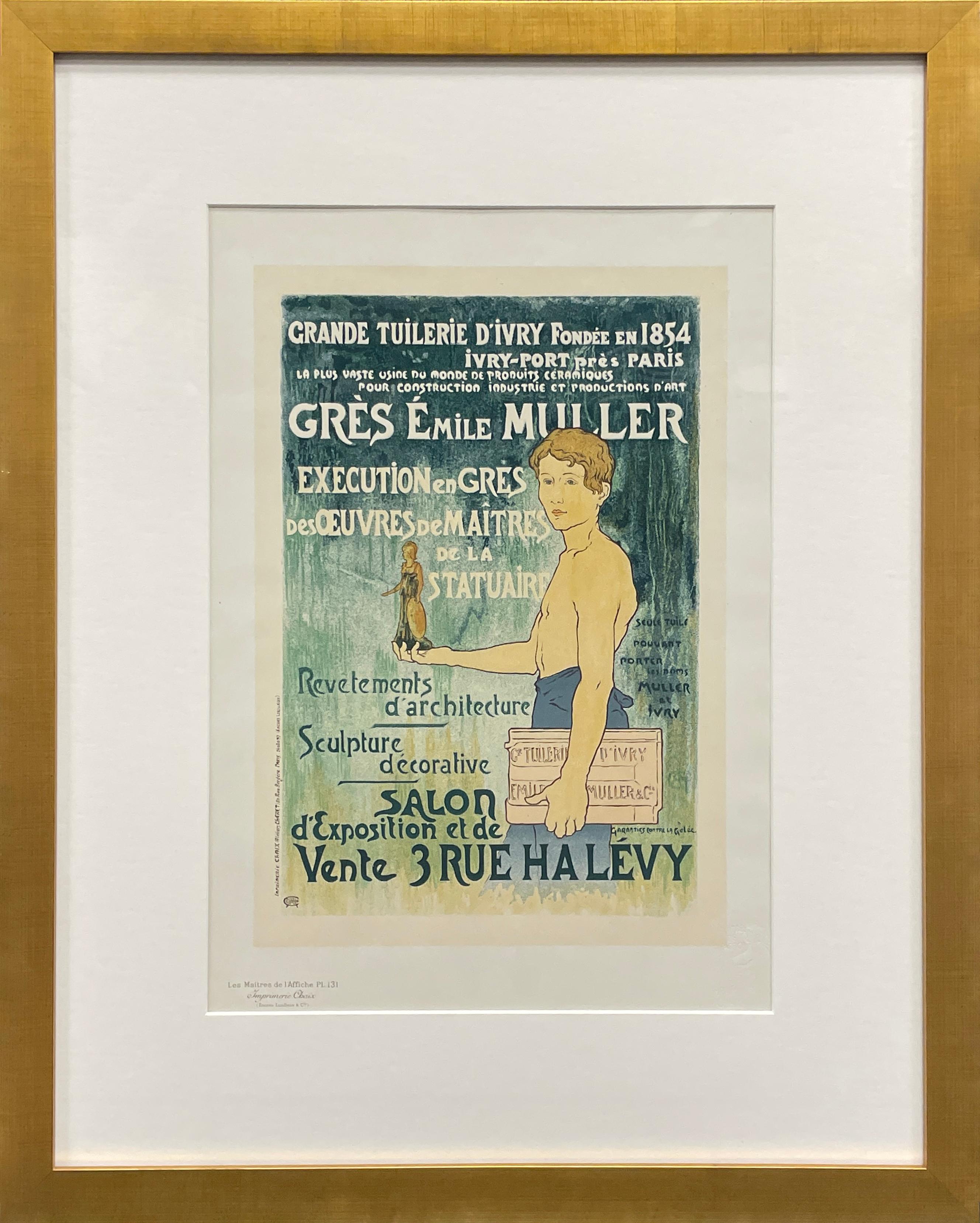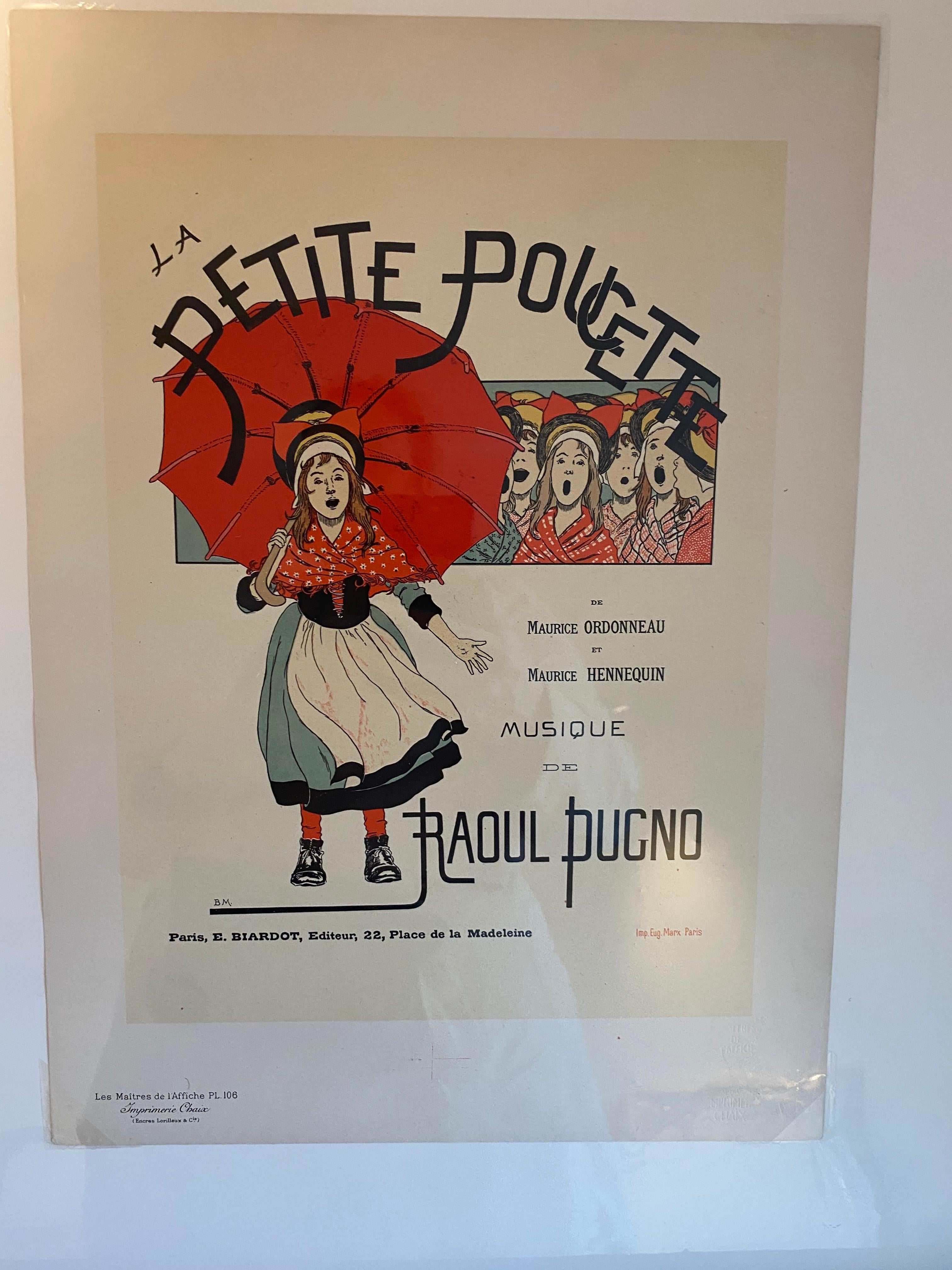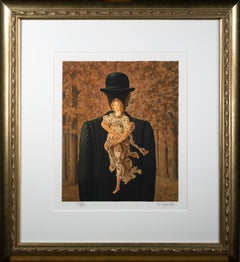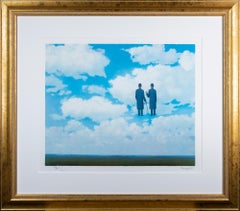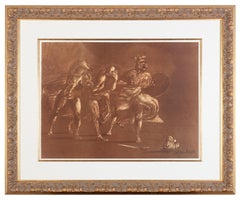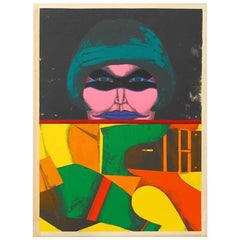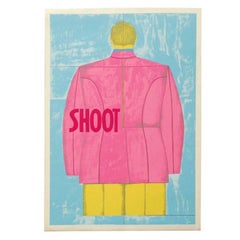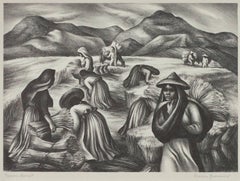
"Mexican Harvest, " Original Lithograph signed by Marion Greenwood
View Similar Items
Want more images or videos?
Request additional images or videos from the seller
1 of 10
Marion Greenwood"Mexican Harvest, " Original Lithograph signed by Marion Greenwood1930
1930
About the Item
- Creator:Marion Greenwood (1909 - 1970, American)
- Creation Year:1930
- Dimensions:Height: 18.875 in (47.95 cm)Width: 22.5 in (57.15 cm)
- Medium:
- Period:
- Condition:
- Gallery Location:Milwaukee, WI
- Reference Number:Seller: 10714g1stDibs: LU60532247553
About the Seller
4.9
Platinum Seller
These expertly vetted sellers are 1stDibs' most experienced sellers and are rated highest by our customers.
Established in 1966
1stDibs seller since 2017
388 sales on 1stDibs
Typical response time: 1 hour
More From This SellerView All
- "Le Bouquet tout fait (The Ready-made Bouquet), " Lithograph after Rene MagritteBy René MagritteLocated in Milwaukee, WI"Le Bouquet tout fait (The Ready-made Bouquet)" is a color lithograph after a 1954 original painting by Rene Magritte. A bourgeois "little man" faces away from the viewer looking towards a fall forest. Flora, the goddess of flowers and season of spring, from Sandro Botticelli's "Primavera" is painted on the back of the man. This juxtaposes fall and spring. Art: 12 x 9.75 in Frame: 22.38 x 20.38 in René-François-Ghislain Magritte was born November 21, 1898, in Lessines, Belgium and died on August 15, 1967 in Brussels. He is one of the most important surrealist artists. Through his art, Magritte creates humor and mystery with juxtapositions and shocking irregularities. Some of his hallmark motifs include the bourgeois “little man,” bowler hats, apples, hidden faces, and contradictory texts. René Magritte’s father was a tailor and his mother was a miller. Tragedy struck Magritte’s life when his mother committed suicide when he was only fourteen. Magritte and his two brothers were thereafter raised by their grandmother. Magritte studied at the Brussels Academy of Fine Arts from 1916 to 1918. After graduating he worked as a wallpaper designer and in advertisement. It was during this period that he married Georgette Berger, whom he had known since they were teenagers. In 1926, René Magritte signed a contract with the Brussels Art Gallery, which allowed him to quit his other jobs and focus completely on creating art. A year later he had his first solo show at the Galerie la Centaurie in Brussels. At this show Magritte exhibited what is today thought of as his first surrealist piece, The Lost Jockey, painted in 1926. In this work a jockey and his steed run across a theater stage, curtains parted on either side. Throughout the scene, there are trees with trunks shaped somewhat like chess pawns with musical scores running vertically up their sides and branches sticking out from all angles. Critics did not enjoy this style of art; it was new, different, and took critical thought to understand, but The Lost Jockey was only the first of many surrealist artworks Magritte would paint. Because of the bad press in Brussels, René and Georgette moved to Paris in 1927, with the hope that this center of avant-garde art would bring him success and recognition. In Paris, he was able to become friends with many other surrealists, including André Breton and Paul Éluard. They were able to learn from and inspire one another, pushing the Surrealist movement further forward. It was also in Paris that Magritte decided to add text to some of his pieces, which was one of the elements that made his artwork stand out. In 1929, he painted one of his most famous oil works: The Treachery of Images. This is the eye-catching piece centered on a pipe. Below the pipe is written “Ceci n’est pas un pipe,” which translates to “This is not a pipe.” This simple sentence upset many critics of the time, for of course it was a pipe. Magritte replied that it was not a pipe, but a representation of a pipe. One could not use this oil on canvas as a pipe, to fill it with tobacco and smoke it. Thus, it was not a pipe. In 1930, Magritte and Georgette moved back to Brussels. Though they would travel to his exhibitions elsewhere, their home going forward would always be in Brussels. Magritte had his first American exhibition at the Julien Levy Gallery in New York City in 1936 and his first show in England two years later in 1938 at The London...Category
2010s Surrealist Figurative Prints
MaterialsLithograph
- "La Reconnaissance Infinie (The Infinite Recognition)" Litho after Rene MagritteBy René MagritteLocated in Milwaukee, WI"La Reconnaissance Infinie (The Infinite Recognition)" is a color lithograph after the 1963 painting by Rene Magritte. Two of Magritte's bourgeois "little men" stand in the sky. Both look away from the viewer talking to each other in the typical outfit of Magritte's men, black trench coats and bowler hats. Art: 15 x 18.25 in Frame: 26.25 x 29.88 in René-François-Ghislain Magritte was born November 21, 1898, in Lessines, Belgium and died on August 15, 1967 in Brussels. He is one of the most important surrealist artists. Through his art, Magritte creates humor and mystery with juxtapositions and shocking irregularities. Some of his hallmark motifs include the bourgeois “little man,” bowler hats, apples, hidden faces, and contradictory texts. René Magritte’s father was a tailor and his mother was a miller. Tragedy struck Magritte’s life when his mother committed suicide when he was only fourteen. Magritte and his two brothers were thereafter raised by their grandmother. Magritte studied at the Brussels Academy of Fine Arts from 1916 to 1918. After graduating he worked as a wallpaper designer and in advertisement. It was during this period that he married Georgette Berger, whom he had known since they were teenagers. In 1926, René Magritte signed a contract with the Brussels Art Gallery, which allowed him to quit his other jobs and focus completely on creating art. A year later he had his first solo show at the Galerie la Centaurie in Brussels. At this show Magritte exhibited what is today thought of as his first surrealist piece, The Lost Jockey, painted in 1926. In this work a jockey and his steed run across a theater stage, curtains parted on either side. Throughout the scene, there are trees with trunks shaped somewhat like chess pawns with musical scores running vertically up their sides and branches sticking out from all angles. Critics did not enjoy this style of art; it was new, different, and took critical thought to understand, but The Lost Jockey was only the first of many surrealist artworks Magritte would paint. Because of the bad press in Brussels, René and Georgette moved to Paris in 1927, with the hope that this center of avant-garde art would bring him success and recognition. In Paris, he was able to become friends with many other surrealists, including André Breton and Paul Éluard. They were able to learn from and inspire one another, pushing the Surrealist movement further forward. It was also in Paris that Magritte decided to add text to some of his pieces, which was one of the elements that made his artwork stand out. In 1929, he painted one of his most famous oil works: The Treachery of Images. This is the eye-catching piece centered on a pipe. Below the pipe is written “Ceci n’est pas un pipe,” which translates to “This is not a pipe.” This simple sentence upset many critics of the time, for of course it was a pipe. Magritte replied that it was not a pipe, but a representation of a pipe. One could not use this oil on canvas as a pipe, to fill it with tobacco and smoke it. Thus, it was not a pipe. In 1930, Magritte and Georgette moved back to Brussels. Though they would travel to his exhibitions elsewhere, their home going forward would always be in Brussels. Magritte had his first American exhibition at the Julien Levy Gallery in New York City in 1936 and his first show in England two years later in 1938 at The London Gallery...Category
2010s Surrealist Figurative Prints
MaterialsLithograph
- Homage a Leonardo d' Vinci (Three Figures Advancing from De La Bataille Vol. I)By Claude WeisbuchLocated in Milwaukee, WIArt: 17" x 23 1/4" Frame: 27 5/8" x 33 7/8" Original color lithograph (VIII/L) Signed lower right. This original Weisbuch lithograph comes from th...Category
1970s Contemporary Figurative Prints
MaterialsLithograph
- "Annette, " by Alberto GiacomettiBy Alberto GiacomettiLocated in Milwaukee, WI"Annette" is an original black and white lithograph by Alberto Giacometti. It depicts the bust of a nude woman in scratchy lines. Annette was Alberto's wife and frequently modeled fo...Category
1960s Minimalist Figurative Prints
MaterialsLithograph
- "Family of Six, " Original Lithograph signed by John Thomas BiggersBy John Thomas BiggersLocated in Milwaukee, WI"Family of Six" is an original black and white lithograph by John Biggers. The artist signed and dated the piece in the lower right and titled and editioned it (AP III) in the lower ...Category
1980s Contemporary Figurative Prints
MaterialsLithograph
- Original Lithograph Native American Figure Portrait Male Tribe Bold Stoic SignedBy Leonard BaskinLocated in Milwaukee, WI"Kill Spotted Horse" is an original lithograph created by Leonard Baskin. It was published by Fox Graphics. This is a proof purchased directly from the artist. Baskin signed the work in the lower right margin and labelled the work as a proof in the lower left margin, written with graphite. It depicts Kill Spotted Horse, an Assinniboine Native American, in a feather headdress against a light blue background. Artwork Size: 15" x 13 1/2" Frame Size: 27 1/2" x 26 3/8" Artist Bio: Leonard Baskin (1922-2000) was an american artist born in New Jersey and taught art classes in Massachusetts. He has received many public commissions (including a bas relief for the FDR Memorial), honors, and his work is owned by many major museums around the world. Additionally, Baskin was a teacher at Smith College in Northampton, Massachusetts. As a champion for human rights, Baskin created many pieces celebrating those who were seldom recognized. Baskin’s interest in nineteenth century Native Americans was roused into acute attendance from ignorant indifference, when the National Park Service asked him to provide illustrations for the handbook that described the then called “Custer National Park”, now called “Little Big...Category
1990s Contemporary Portrait Prints
MaterialsLithograph, Ink
You May Also Like
- Masked Woman Signed LithographBy Richard LindnerLocated in Rio Vista, CARichard Lindner (German/American 1901-1978) original hand signed in pencil lithograph "Masked Woman". Unframed #16 of 100 dated and stamped lower right 1971.Category
20th Century Modern Figurative Prints
MaterialsPaper, Lithograph
$1,200 Sale Price20% Off - Shoot "Back" LithographBy Richard LindnerLocated in Rio Vista, CAUnframed Richard Lindner (German/American 1901-1978) original hand signed in pencil lithograph #16 of a series of 100 dated and stamped lower right 1971. Shoot (back) from a series o...Category
20th Century Pop Art Figurative Prints
MaterialsPaper, Lithograph
$950 Sale Price20% Off - Sandeman Porto & Sherry – Iconic Original PosterLocated in Zurich, CHThe Don: One of the most recognizable figures in poster history ever, quietly reveling in the simple delights of a glass of ruby port – typically thought of as a horseman, clad in a ...Category
1920s Art Deco Figurative Prints
MaterialsPaper, Lithograph
- Henri Toulouse Lautrec, Original Lithograph 1897By Henri de Toulouse-LautrecLocated in Saint Augustine, FLArtist: Toulouse Lautrec (1864 -1901) French Title: The Chestnut Vendor Medium: Lithograph, Year: 1897 Signature: Signed in Plate (TL) Lower Left Dimensions: 20” x 17” Framed, 11” x 8.5” Unframed A lithograph of a Toulouse Lautrec drawing...Category
Late 19th Century Post-Impressionist Figurative Prints
MaterialsLithograph
- "Quest of the Golden Girl" from Les Maitres de l'AfficheBy Ethel ReedLocated in Hinsdale, ILREED, ETHEL (1874 -1926) "Quest of the Golden Girl" Original lithograph from "Les Maitres de L'Affiche" series Printed by Imprimerie Chaix, Paris Bea...Category
1890s Art Nouveau Figurative Prints
MaterialsLithograph
- "The New Woman" from Les Maitres de l'Affiche by MorrowLocated in Hinsdale, ILMORROW, ALBERT GEORGE (1863 -1927) "The New Woman" Original lithograph from "Les Maitres de L'Affiche" series Printed by Imprimerie Chaix, Paris Bearing MDL stamp lower right, c. 1897. Plate #79 Unframed Size: 11 3/8 x 15 3/4 ”The "Les Maitres de l'Affiche" series was offered as a subscription series to collectors every month for 60 months, from December 1895 through November 1900. The "Maitres de l'Affiche," were issued as separate numbered sheets, referred to as "plates". They were numbered, with the printers name "Imprimerie Chaix," in the margin at the bottom left hand corner, "PL.1" to "PL.240." In the margin at the bottom right hand corner of each, is a blind embossed stamp from a design of Cheret's. The smaller format and the fact the "Maitres" were a paid subscription series, allowed Imprimerie Chaix to use the latest state of the art printing techniques, not normally used in the large format posters...Category
1890s Art Nouveau Figurative Prints
MaterialsLithograph
Recently Viewed
View AllMore Ways To Browse
Vintage Indian Girl
Lazaro Painting
Dali Lithographs Numbered And Signed
Vintage Dress Form Art
Letter J
Dali Gold
Early American Beds
Salvador Dali Signed Drawing
20th Century Japanese Woodblock Prints
New York State Poster
Monumental Church
Pop Art Retro Illustration
House Alter
King Lithograph
Birth Plates
Original Art Nouveau Posters
Whistle Antique
Warrior Prints
